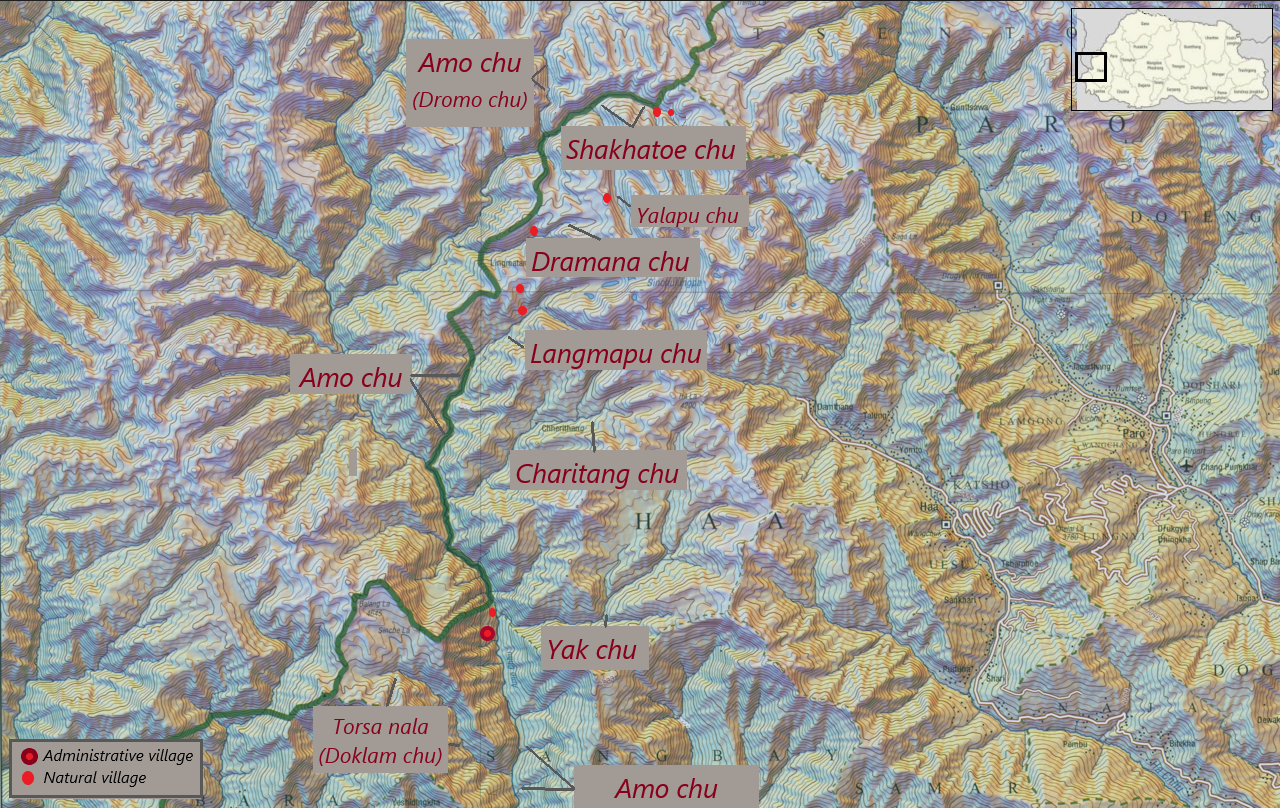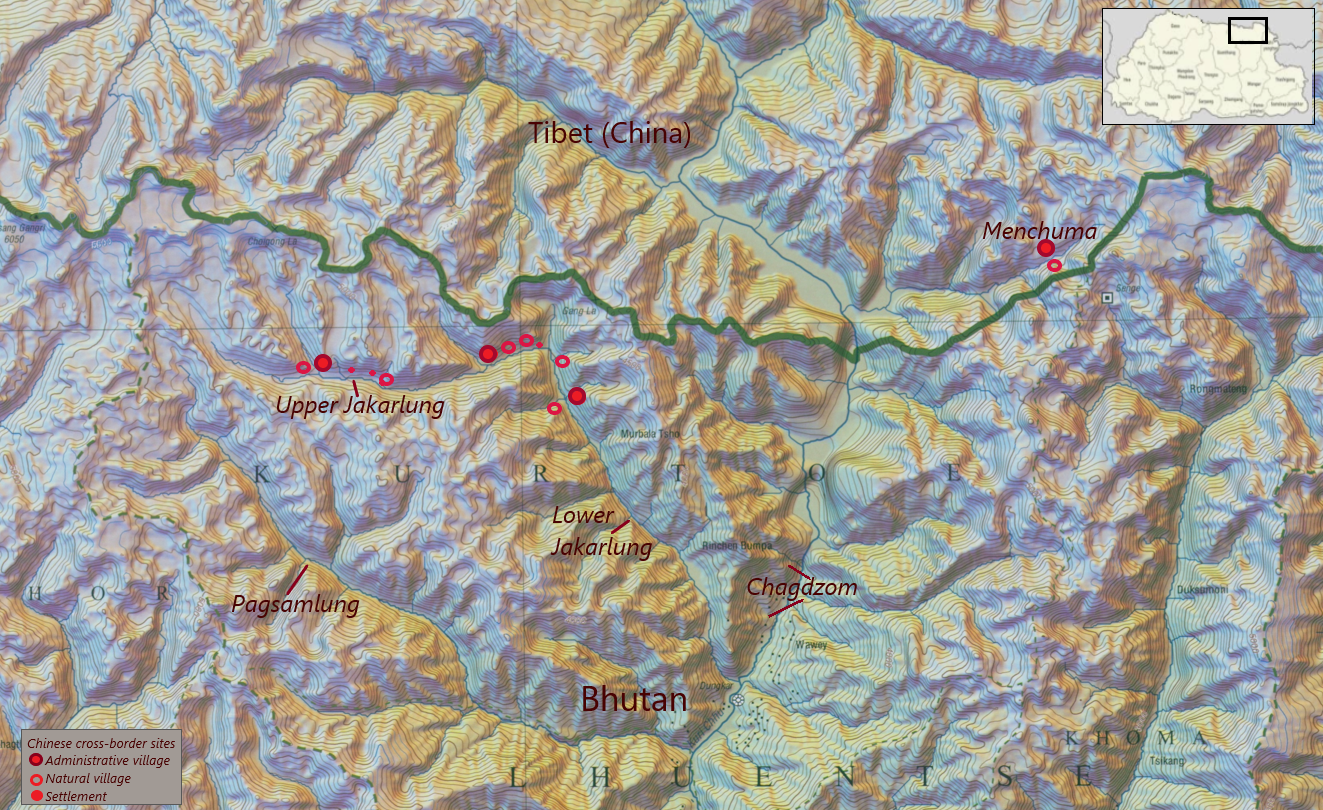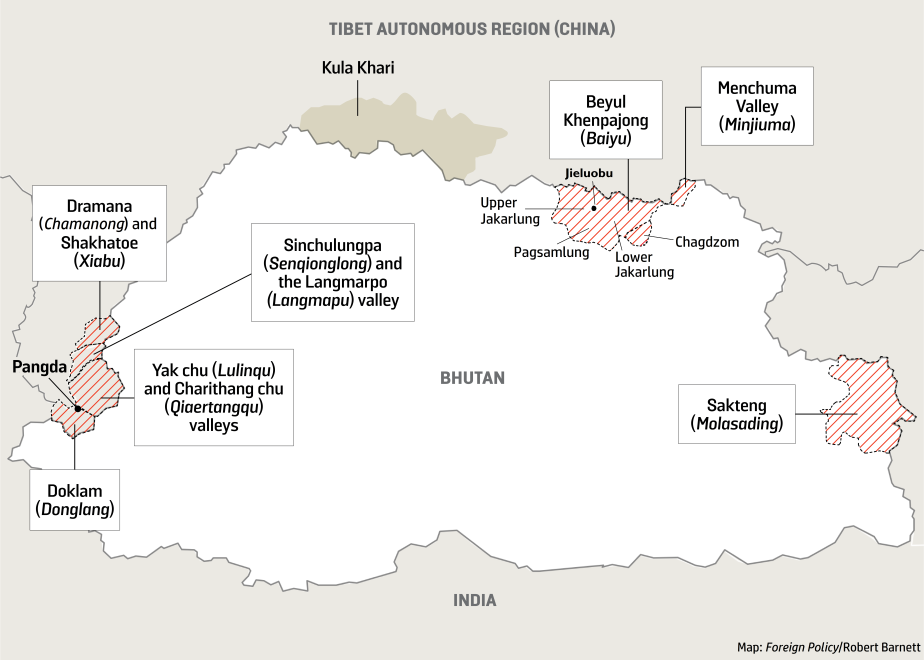In dealing with its neighbors, China “always strives to find fair and reasonable solutions through peaceful and friendly consultations,” a spokesman for the Chinese Embassy in the United States told the New York Times in August. Why, then, has China appropriated part of a neighbor’s territory?
That neighbor is Bhutan, a country with which China has said for decades it is keen to have formal diplomatic relations, hoping to balance or reduce Bhutan’s close relations with its southern neighbor, India. Bhutan, for its part, has what it calls “friendly and cooperative relations with the People’s Republic of China” and has supported China consistently at the United Nations and elsewhere.
As China’s Foreign Minister Wang Yi has put it, in more poetic terms, “China and Bhutan are linked by mountains and rivers and enjoy profound traditional friendship.” And China signed a treaty with Bhutan in 1998 in which both parties proclaimed “mutual respect for each other’s sovereignty and territorial integrity” and agreed “not to resort to unilateral action to alter the status quo of the border.”
What has since happened is the opposite. Eight years ago, China began building villages within territory that has for decades if not centuries been within Bhutan. Now, as documented in a report out today, there are 22 such villages and settlements built by China within Bhutan’s customary borders. And there is no sign that Bhutan can do anything about it – or that China will face any costs for doing so.
As far as one can tell from satellite images, the Chinese villages and settlements in total contain some 2,200 homes for approximately 7,000 people. To construct these villages, China has annexed 2 percent of Bhutan’s territory.
The villages are being built in two areas of Bhutan. Eight of the Chinese villages are in a western area of Bhutan that the historian Tsering Shakya said was ceded to Bhutan by the then ruler of Tibet, the 13th Dalai Lama in the early 20th century. China has built those eight villages for military reasons: it wants that western area of Bhutan because it includes an 89-square-kilometer area called Doklam, possession of which would give China major strategic advantage in its ongoing confrontations with India.

Bji Gewog in Haa dzongkhag (district), western Bhutan. Base map: 1:250,000 Map of Bhutan, Department of Survey and Land Records of Bhutan, Ministry of Agriculture, Thimphu, 1st version, 2006. The international border between Bhutan and China is as shown on the base map. Names of valleys and sites of cross-border villages have been added.
The 14 other Chinese villages and settlements are in areas of northeastern Bhutan known as the Beyul Khenpajong and Menchuma. These areas have always been understood to be in Bhutan. China produced a claim for these areas only in the 1980s and until at least the early 1990s they were shown on official Chinese maps as parts of Bhutan.

Kurtoe Gewog in Lhuentse dzongkhag (district), northeastern Bhutan. Base map: 1:250,000 Map of Bhutan, Department of Survey and Land Records of Bhutan, Ministry of Agriculture, Thimphu, 1st version, 2006. The international border between Bhutan and China is as shown on the base map. Names of valleys and sites of China’s cross-border villages have been added.
These northeastern areas of Bhutan have no compelling military or strategic value to China. Its reason for annexing them was more or less explicitly to place diplomatic pressure on Bhutan. In 1990, in what has become known as the “package deal,” Beijing offered to drop its claims in the northeast of Bhutan if Thimphu would yield a number of claimed territories in its west, including Doklam, to China. In other words, the Chinese villages in the northeast were built within Bhutan’s customary borders as a threat: if Bhutan didn’t agree to the package deal and yield the western areas, the threat implied, it would lose the northeastern areas too.
That threat appears to have been largely realized. Without any public comment, and unnoticed even within the country, let alone abroad, Bhutan has already changed its maps so that Menchuma, one of the northeastern areas occupied by China since the 2000s, is no longer shown as part of Bhutan, though it clearly was some 30 years ago – even on China’s maps.
And in March last year, two years after reports emerged of Chinese villages within Bhutan, Bhutan’s then-prime minister finally said that those reports were false. The statement does not, however, mean that those reports were false when they were published. Instead, it suggests that now Bhutan does not expect to be able to recover the areas where China has built its cross-border villages.

Map showing the principal areas of Bhutan currently claimed by China. China is building villages in the western sector of Bhutan (in Bji Gewog in Haa dzongkhag) and in the northeastern sector (in Beyul and Menchuma in Lhuentse dzongkhag). Bhutan ceded Kula Khari (Gasa dzongkhag) to China in the 1980s, and in 2020 China made a public claim to Sakteng in the eastern sector. Source: Foreign Policy/Robert Barnett 2021.
From Leverage to Punishment
China’s eight villages in Bhutan’s west are part of what China calls a “consolidation” or “fixing” tactic: they are a way of acquiring territory by creating “facts on the ground” that another party can hardly change without triggering a war. In this sense, they are like China’s actions in the South China Seas.
But the 14 villages and settlements in the northeast of Bhutan represent a completely different rationale: not the seizing of a strategic asset but what seemed to be a temporary occupation, a signal to Bhutan that it should yield to pressure. This was indicated by the fact that, in 2018, when China finished building its first cross-border village, which was in the northeast of Bhutan, it had only 16 residents.
By early 2023, when Bhutan announced that it was close to reaching a deal with China and that there were no Chinese villages on its soil, that pressure appeared to have paid off for China. Yet China’s building spree in Bhutan’s northeast continued. At the end of 2022, there were 14 villages and settlements, built over six years. But in the 18 months since early 2023 seven more have been built, and three existing villages have been majorly expanded and are currently being upgraded from villages to towns. This surge of construction has added another 790 units of Chinese housing in the northeast of Bhutan, tripling the housing stock in that area, which until recently China had not apparently seen as of strategic significance.
These new villages and settlements are not required to increase China’s pressure on Bhutan – Thimphu seems close to yielding to most of China’s demands, since it has no other option. Rather, they seem to represent punishment of Bhutan because it cannot yield Doklam to China. Legally speaking, Bhutan cannot do so unless India agrees, because of a 2007 treaty between Bhutan and India obliging either side not to “allow the use of its territory for activities harmful to the national security and interest of the other.” So China’s continuing occupation of parts of Bhutan and the expansion of its cross-border villages is penalizing Bhutan for having failed to accept an element of the package deal that it has no power to enact.
If, as seems likely, Bhutan yields the non-Doklam western areas demanded by the Chinese government, it will get some rewards from China, in that Beijing will most likely drop its claims to those areas of Bhutan that it has claimed but not occupied. These areas are the Upper Langmarpo, Charithang, and Yak chu areas in the west and the Chagdzom area in the northeast, totaling about 430 sq km. China’s claims to those areas are viewed by some observers as “trade space” – token demands made only to be dropped later so as to give the impression of good will.
It is also likely that China will give back the Pagsamlung valley, an area of religious and historic significance for Bhutan which China has annexed by building roads and outposts and by stationing troops, but where it has not constructed villages. Returning the Pagsamlung valley to Bhutan would not, however, be a genuine concession either, because China does not include the Pagsamlung as part of China on its national-level maps (some local-level Chinese maps do include it as part of China), and has not done so for at least 25 years. So in the case of the Pagsamlung valley, China has occupied a piece of a neighbor’s territory that it does not even claim.
Conflict Without An Enemy
China’s land-grabs in Bhutan thus differ from Beijing’s actions in the South China Seas. Firstly, unlike the Spratly Islands and other maritime features in the critical waterway, most of China’s villages in Bhutan are not in areas of major strategic value, apart from Doklam. Their value was primarily as a form of pressure on the Bhutan government to yield the Doklam plateau.
Second, China’s actions in the South China Sea – claiming territory on dubious grounds and then building unilaterally on that territory – were hostile acts directed at competitors or antagonists. But China supposedly views Bhutan as a friend, and Bhutan cannot, because of its size, resources, and geography, resort to any form of antagonistic response. China could have used multiple other options to place diplomatic pressure on Bhutan without seizing its territory and openly breaching an international agreement.
Bhutan has in any case, since at least the early 1990s, indicated its interest in opening formal relations with Beijing and settling the border disputes, apart from the Doklam issue, which depended on getting agreement from India. Bhutan’s willingness was never the problem, and even the use by China of territorial annexation as an extreme form of pressure on Bhutan was always unlikely to get India to agree to Doklam being yielded to China.
A realist might see China’s actions as what the political theorist Thomas Schelling called “coercive diplomacy,” or, more particularly “compellence” – a muscular form of dominance-assertion. But Schelling’s theory always assumes an adversary, leaving the coercing power with relatively few options. That is the opposite of the case here: Bhutan has not claimed anything that China held before its recent annexations, and could not compete with China even if it did.
In addition, coercive diplomacy involves a threat that is not fulfilled unless there is non-compliance (think Kennedy and the Cuban Missile Crisis). But in the case of Bhutan, the threat was carried out in advance, making it closer to Schelling’s “forcible action” (which he also called “brute force”), with the unlikely promise of withdrawal if Bhutan were to concede to the demand – which China’s strategists must have known that in all likelihood it could never do in full.
Beijing’s actions are of course ultimately directed against India, with which China is locked into a long-running border conflict. But the only damage being done here is to Bhutan, not India. For its part, India has shown interest only in the Doklam issue – or more precisely in the southern ridge of Doklam, which gives oversight of India’s bottleneck at Siliguri.
In June 2017 India sent 270 troops into Doklam to prevent Chinese soldiers taking that ridge, leading to a 73-day standoff between Indian and Chinese army units. But India has not commented publicly or responded to China’s incursions or appropriation at other points along the Bhutan-China border, and not even to China’s seizure of the majority of the Doklam plateau just to the north of the ridge, where China has built multiple roads, barracks and military facilities in what is clearly disputed territory.
So why would China risk its stated goal of establishing formal relations with a friendly neighbor, and its much-proclaimed commitment to a “peaceful rise,” in order to punish India, a third party that, as far as is known, is involved only in one small sector of that border? And why would China continue building villages in the northeastern area of Bhutan – at mind-numbing expense, given their remoteness, altitude, and climate, as a result of which every settler in those villages has to be paid large sums by the Chinese government to agree to live there – long after the utility of those villages as leverage has passed, literally, the point of no return?
Domestic factors can play a role in these situations – local Chinese power-holders in Tibet stand to gain significant funding from Beijing for their administrations by claiming that they face security threats from northern Bhutan. However, the only threat that Chinese media have cited as coming from Bhutan – since the Indian military has little presence in Bhutan other than at Doklam – is the possibility that exiled Tibetan supporters of the Dalai Lama might somehow try to cross into Tibet via Bhutan to foment an independence movement. But there have been almost no reports of illegal border crossings in the last ten years on any part of Tibet’s 4,000 km-border (91 percent of which is with India or Nepal, not Bhutan), and even before then there were no reports of any trying to cross via Bhutan.
The use of annexation as a diplomatic tool matches with a recent shift by China from soft-power approaches to hard-power moves in its foreign relations, in particular with regard to Taiwan, the Philippines, and India. Some have presented realist explanations for these developments, arguing that China sees those states as posing threats of some kind to its security. Others have seen China’s combination of a declared commitment to a soft-power approach with the reality of its hard-power politics as designed, intentionally or not, to create confusion for observers and reduce predictability. But such arguments have little purchase in the case of Bhutan, since it does not pose a threat to China. Instead, the Bhutan case demonstrates the widest instance so far of a gulf between China’s rhetoric and practice in its policy towards its neighbors, especially the smaller ones.
A New Cost-free Norm?
But there is another factor that may be more significant than normative assumptions of rationality or threat-response: the lack of cost. The exercise by states of their coercive powers is presumably constrained by the costs of excessive actions. In the Bhutan case, there have been no costs, not even of the mildest kind.
The mainstream media, other than those in India, have mostly ignored the issue, apart from news pieces by the New York Times in 2020, Reuters in 2021, and the Wall Street Journal in 2024, three years after the first major reports of cross-border village-construction (besides a Washington Post op-ed I wrote in 2020). Criticisms of China are routine in Western media – the BBC and the Guardian, for example, recently covered extremely doubtful allegations of Chinese abuses in Tibet based on such slender evidence as photographs of students wearing military-type fatigues or insignificant shifts in nighttime light emissions. But neither outlet has carried anything about China’s annexation of territory within another country, seemingly a challenge to a founding principle of the United Nations.
As for governments, Bhutan and India have been largely silent on the issue, surely the wisest option for them in this situation. But it remains unclear why other governments or politicians have been quiet about China’s annexation of parts of Bhutan. All the reports of village construction in disputed territory have long since been confirmed by satellite imagery, and the U.S. military has issued two reports judging China’s village-building program in Bhutan to be potentially a case of occupation (one in October 2023, and another in much greater detail in March this year). Rabid anti-China rhetoric is never helpful, but near-total silence risks signaling acquiescence by the wider community to the use of territorial annexation as a tactic of choice with small neighbors.
The reason why China chose this hard-fisted tactic against Bhutan may thus be because it rightly calculated that the costs would all be Bhutan’s. Given its commitment to long-term considerations, Bhutan has no effective option but to continue as if its powerful northern neighbor is a friend, to accept the Chinese deal as far as India will allow, and to open formal relations with Beijing. As then-Prime Minister Lotay Tshering said last year, “How can Bhutan not have any bilateral relations with China? The question is when, and in what manner.”
China may not end up with control of the southern ridge at Doklam, but its cross-border actions elsewhere in Bhutan have already demonstrated the effectiveness of land appropriation as a cost-free means for a major power to extract concessions from a smaller neighbor.

































